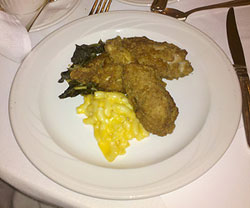It was a room full of black folks with, I’m sure, one collective thought: These white men looking down on us from their gold-framed pictures must be turning over in their graves.
Not turning over just once – as a friend pointed out, noting that others like us had been in this room – but twirling like whirlwinds. These men were the former presidents of Philadelphia’s most prestigious and exclusive members-only Union League. Their pictures hung triple-rowed on the wood-paneled walls of Lincoln Hall, where blacks, women and anyone unlike them were forbidden up until 40 years ago.
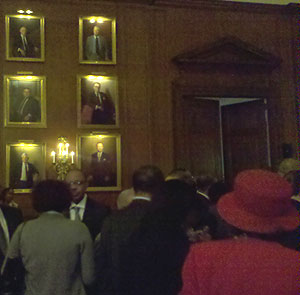
I was there as an invited guest of former Philadelphia Inquirer columnist Acel Moore, who was among three people who received awards for their accomplishments. The others were Cathy Hughes, founder and chairwoman of the board of Radio One, and soon-to-be-100-years-old the Rev. Thomas W.S. Logan Jr.
Not just anyone can hold an event at this club, where a beautiful antique Tiffany clock made especially for the league greets you at the entrance and a copy of the Emancipation Proclamation lies stored in the Heritage Center on the lower level. The host of this event was a Union League member and Republican, the owner of one of the country’s oldest African American newspapers, Robert W. Bogle of the Philadelphia Tribune.
The social and political elite of black Philadelphia were his guests at the paper’s second Black History Awards Luncheon. A roomful of blacks as an uncommon presence here was not lost on any of us, including some of the speakers.
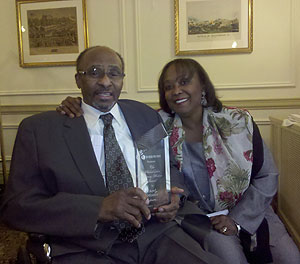
“I lived six and a half blocks away but Lincoln Hall was a universe away,” said H. Patrick Swygert, president emeritus of Howard University and a former executive vice president at Temple University in Philadelphia. “My parents taught us that it was actually six and a half blocks away.”
When I entered the building, I took what seemed like a long walk from the entrance down a hallway of marble floors with meeting and eating halls on either side. On the walls were huge paintings bearing such names as Xanthus Russell Smith and James Reid Lambdin, who had been members, and I believe I saw a William Trost Richards.
On the second floor, I wandered curiously down a hallway and came upon two rooms with bookshelves, but I didn’t venture too far inside because meetings were taking place. A staffer told me later that one of those was the Lincoln room with a statue of Abraham Lincoln along with his Gettysburg Address.
He also asked if I’d seen the pictures of the U.S. presidents down another hallway. “They’re all Republicans,” he said, in the tradition of the men who founded the league.
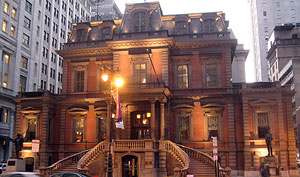
I also didn’t visit the Heritage Center, which has a copy of the 1864 Leland-Boker authorized edition of the Emancipation Proclamation. Lincoln signed 48 copies – there apparently are 24 known copies – and they were sold for $10 as souvenirs to raise money for sick and wounded soldiers. I saw a copy last year that had been owned by Sen. Robert F. Kennedy and was later sold at auction.
I could never afford to belong to the Union League, and as colleagues and I agreed, would never want to. Too stuffy, too unnatural a place to be comfortable. We couldn’t afford it anyway: Initiation fees are around $3,000 and then we’d have to fork over $3,000 a year or so to remain a member, according to one staffer.
Nor could we bide the rules: cell phones, laptops and other digital devices must be used discreetly; and no jeans, T-shirts, sneakers or baseball caps. I dressed so casually for the luncheon that for half-a-second, I felt uncomfortable when a friend told me the dress code required women to wear dresses or nice pantsuits.
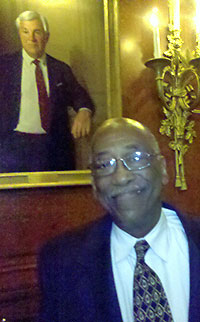
The group of black folks were dressed appropriately. But still, this setting was a far cry from not just 150 years ago when the league was founded but 60 years ago when Don Hackney sat for another awards dinner.
Hackney, in junior high, was among a group of boys being honored for their athletic skills as part of a citywide crime-prevention program in 1953. He was the only black person (there were only a few in the room) at his table, he recalled, along with some players from the Philadelphia Phillies.
His mentor John Green accompanied him but seemed to have disappeared when Hackney was guided to his table. Green was not allowed to sit in the main room, Hackney learned later. “He sat in the kitchen. He peeped through the door to see if I was all right.”
While sitting there, Hackney remembered, he felt a sting like a bee sting on his neck but thought nothing of it. “When I got home, I looked at my shirt. Coffee had spilled down my neck.” He didn’t think it was deliberate until years later when someone suggested that it was.
It’s “mind-boggling,” he said. “Mr. Green was in the kitchen and now we have an affair here. Times have changed, to some extent. To some extent, they haven’t.”
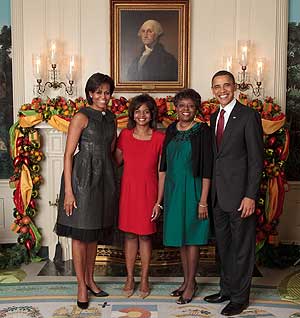
But the Union League has come a long way, baby, even if it still has a ways to go. It was founded in 1862 by Republican movers and shakers who wanted to show support for Lincoln and the Union during the Civil War. The league has a long history of inclusion of white men and exclusion of everyone else. African Americans were not allowed to join until 1972. Interestingly, a Beaux Arts addition to the building in 1910/1911 was partly the design work of a black Philadelphia architect named Julian F. Abele working for the firm of Horace Trumbauer.
Women – even wives and daughters of the male members – were only allowed in the ladies dining room. That changed in 1986, when five women were admitted as members – one of whom became president in 2010.
At the awards luncheon, a friend noted that the setting mimicked her experience during a correspondents dinner at the White House where members of the press took photos with President Obama and his wife Michelle. They stood beneath a painting of George Washington staring down upon them – him, too, likely wondering how the heck they had come so far.
Apparently, we haven’t come far enough that we’ve forgotten our roots. The choice of food for the luncheon was decidedly not Union League: fried chicken, mac and cheese and collard greens. “The chicken was not cooked by them,” one of the servers said. “It was brought in. It’s not on their menu.”
Someone at my table even wondered if there was hot sauce, and asked a waiter if they had any. They did, and it arrived not in a Louisiana hot sauce bottle – that would be too crass for the league – but in a small white cup with a tiny spoon.
